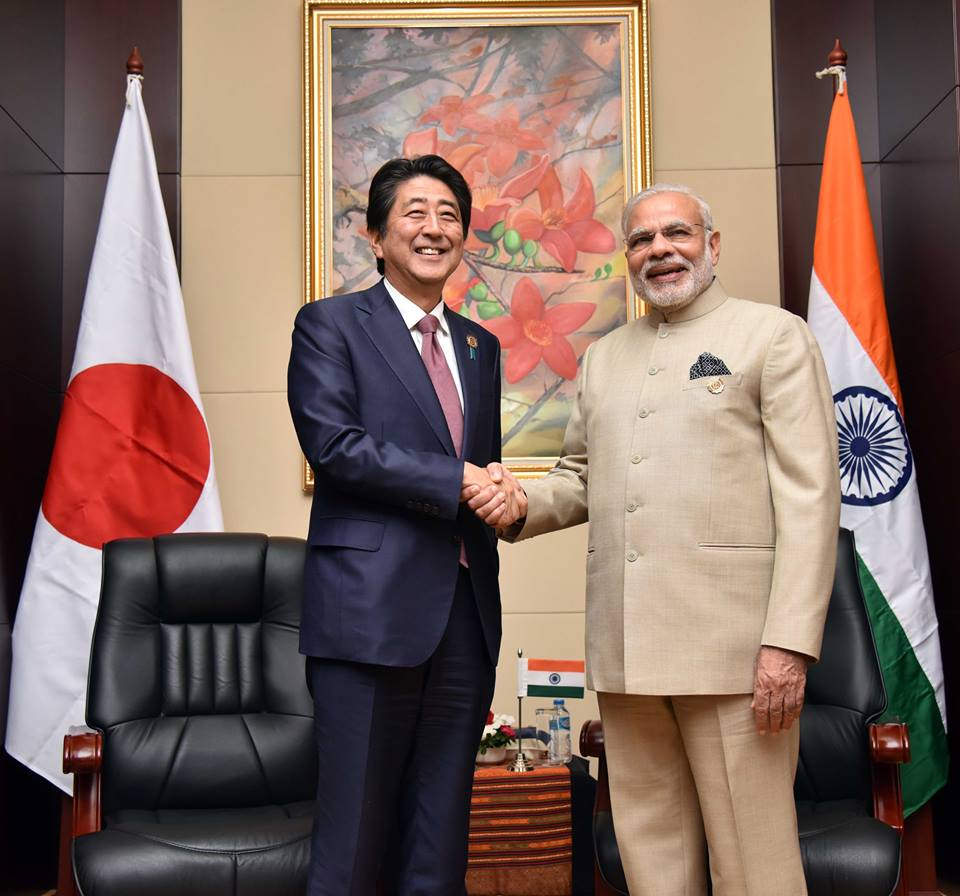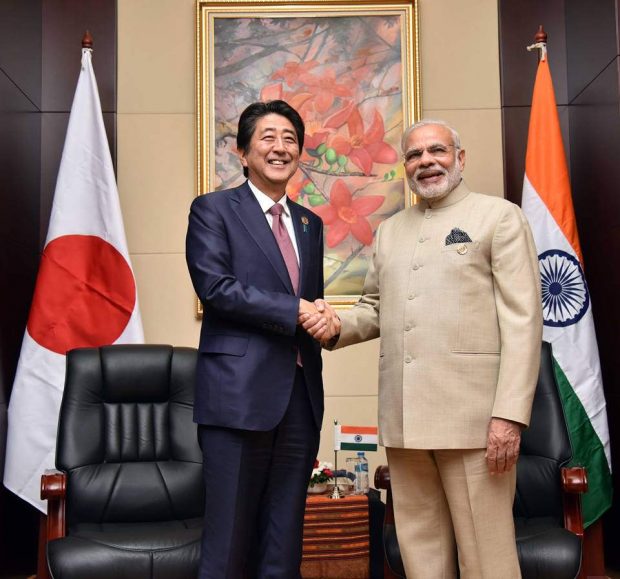
Why Tokyo and New Delhi Are Reaching Out to Beijing and Vice Versa
The volatility of US President Donald Trump’s administration has thrown many a government across the world into a tizzy. With Washington blowing hot one day and cold the next, foreign-policy mandarins in various world capitals have been burning the proverbial midnight oil, trying to develop strategies to deal with the maverick administration.
India and Japan are no different. While Tokyo is a steadfast American ally and New Delhi is growing closer to both Tokyo and Washington, there are quite a few issues that continue to bedevil ties between Washington and Tokyo and between New Delhi and Washington. On the one hand, the United States has been crying itself hoarse about the trade deficit with Japan, while on the other, it has slapped sanctions on some specific Indian exports. The US has also pulled out of the Trans-Pacific Partnership (TPP) trade accord, although Japan subsequently chaperoned the TPP process without the US, resulting in the signing of the Comprehensive and Progressive Agreement for Trans-Pacific Partnership (CPTPP), also known as TPP-11, in March this year in Santiago, Chile.
In addition, the Trump administration’s penchant for cutting deals has also prompted Japan and India to look at other options. Tokyo was caught off guard by Washington’s growing bonhomie with Pyongyang, for example. In the past, North Korea has threatened Japan with extinction, and last year conducted two missile tests that flew over Japan.
Beijing, meanwhile, has been reeling from the impact of US tariffs, leading to a situation where China has been sending out feelers to both India and Japan. For their part, Tokyo and New Delhi have reciprocated by grabbing Beijing’s hand. So is this the “new normal” in ties between India and China and between Japan and China?
India and Japan share a difficult past and disputed borders with China — a land border in India’s case, a maritime border in the case of Japan. This new equation among the three countries merits deeper analysis and is the product of several factors.
India’s China Options
China is India’s largest bilateral trade partner, and India has a long land border with China. Both are part of the so-called BRICS countries along with Brazil, Russia and South Africa. New Delhi has no option but to deal with Beijing, hence the Wuhan Informal Summit that was held in late April this year after the tense 2017 standoff between India and China over road construction in Doklam in Bhutan. India and China also have deep strategic interests in stabilizing Afghanistan. In addition, both are developing countries and have been co-operating on climate change — but both are loath to agree to binding emission cuts. After the Wuhan summit between Indian Prime Minister Narendra Modi and Chinese President Xi Jinping, the Indian Ministry of External Affairs noted in a press release that the two leaders “believe that the simultaneous emergence of India and China as two large economies and major powers with strategic and decisional autonomy, has implications of regional and global significance. They shared the view that peaceful, stable and balanced relations between India and China will be a positive factor for stability amidst current global uncertainties.”1
Likewise, at the Shangri-La Dialogue in Singapore in June this year, Modi noted that the informal April summit with Xi “helped us cement our understanding that strong and stable relations between our two nations are an important factor for global peace and progress. I firmly believe that Asia and the world will have a better future when India and China work together in trust and confidence, sensitive to each other’s interests.”2
However, there are many areas where India and China do not see eye to eye. The disputed border and memories of the short border war fought in 1962 after Chinese troops invaded India remains an issue. The two sides have also been at loggerheads over China’s growing influence in India’s “strategic backyard” — South Asia. Beijing’s influence has grown in countries such as Sri Lanka, where it has picked up a majority stake in the port of Hambantota, and in Nepal and the Maldives, where a pro-China government was in power until recent elections put in place a new president more favorably inclined towards India.
In addition, China’s so-called string of pearls strategy is to build ports in Gwadar (in Pakistan), Chittagong (in Bangladesh) and Kyaukpyu (in Myanmar), in addition to Sri Lanka. Beijing is also pushing the China-Pakistan Economic Corridor (CPEC), which is designed to change the face of the Pakistani economy. Given India’s troubled relationship with Pakistan, any deterioration in ties with China will only give more leverage to Pakistan, something which New Delhi clearly understands.
At the same time, New Delhi has not joined the Beijing-led Belt and Road Initiative (BRI). India’s Ministry of External Affairs said in a statement that “we are of firm belief that connectivity initiatives must be based on universally recognized international norms, good governance, rule of law, openness, transparency and equality. Connectivity initiatives must follow principles of financial responsibility to avoid projects that would create unsustainable debt burdens for communities; balanced ecological and environmental protection and preservation standards; transparent assessment of project costs; and skill and technology transfer to help long-term running and maintenance of the assets created by local communities.”3
Japan and China — Agreeing to Disagree
Meanwhile, Tokyo has been making overtures to Beijing, despite major political differences. Japanese Prime Minister Shinzo Abe made a state visit to China in late October, during which the two sides signed nearly 500 business deals worth approximately $2.6 billion. In addition, they signed a $30 billion currency swap agreement. This year also marked the 40th anniversary of the signing of a friendship treaty between Japan and China. Tokyo needs Beijing’s help as it seeks to come to grips with North Korea, which has come out of the diplomatic wilderness following the Singapore Summit in June between US President Donald Trump and North Korean leader Kim Jong Un. Without a doubt, Beijing has the biggest influence on Pyongyang.
It is also worth noting Japan’s territorial dispute with Russia, and any further tensions with China would be detrimental — something Abe clearly understands. China, of course, also has its territorial dispute with Japan over the Japanese-held Senkaku Islands (claimed by China as the Diaoyu Islands). In addition, there have been many instances of Chinese bombers and fighter jets violating Japanese airspace, with Japan scrambling aircraft to intercept them. Japan has also been sending out mixed signals with regard to the BRI. There are more than 30,000 Japanese companies operating in China, and during the Belt and Road Forum held in Beijing, a representative from Japan’s ruling Liberal Democratic Party (LDP) attended the conference, although Japan did not participate directly.
Japan, India and the US — New Best Buddies
Against this backdrop, relations between Japan, India and the US have been improving by leaps and bounds. The Malabar naval exercise, which began as a bilateral exercise between India and the US in 1992, saw Japan became a permanent member in 2015. The three countries have also been holding a trilateral dialogue since December 2011. There are many other international forums where the three are actively collaborating. Meanwhile, the first-ever trilateral meeting between the Indian and Japanese prime ministers and the US president was held on the sidelines of the G-20 Summit in Argentina in early November. On the occasion, Modi remarked that “If I put it differently, Japan, America and India is ‘JAI.’ In Hindi, ‘JAI’ means success.”4
What is also bringing India, Japan and the US closer is the fact that India is increasingly buying military hardware from the US — unlike in the past, when Russia was its major supplier of military hardware. The increasing use of the term “Indo-Pacific” in both scholarly and policy-making circles also reflects the growing importance of India. One significant sign was the change in name of the US Pacific Command to the US Indo-Pacific Command, reflecting a change in US calculations about India.
Growing India-Japan Ties
New Delhi and Tokyo are collaborating in a wide variety of areas, especially on infrastructure development. Tokyo has provided soft loans to India to develop of a high-speed railway corridor between Mumbai and Ahmedabad at a very nominal rate of interest. This railway corridor is expected to be completed by 2023. Then there is a civilian nuclear deal between Japan and India, which is very significant, since Japan is the only country to have been impacted by atomic weapons. In addition, during the visit of Modi to Japan in late October, the two countries signed a currency swap agreement to the tune of $75 billion.
The two countries have also been collaborating on defense, holding joint naval exercises known as the JIMEX. This year for the first time, they held joint exercises between their armies, known as “Dharma Guardian,” in Mizoram in Northeast India. At the same time, India’s Andaman and Nicobar group of islands lies astride key sea lanes of communication in the Indian Ocean and at the entrance of the Straits of Malacca. New Delhi and Tokyo are working on a maritime agreement, and in the future, Japan Maritime Self-Defense Force vessels could make use of these facilities.
The two countries are also planning to collaborate in third countries and regions such as Sri Lanka and Africa. The Asia-Africa Growth Corridor (AAGC) envisages co-operation between India and Japan in Africa, given India’s long historical links with Africa and Japan’s financial muscle. In addition, the so-called Quad, which involves India, Australia, the US and Japan, was resuscitated on the sidelines of the East Asia Summit in Manila in November last year. Another key factor generating Japanese interest in India is the fact that India has one of the fastest-growing economies in the world and it will also soon have the world’s largest population.
The New Normal?
China’s status as a permanent member of the UN Security Council with veto power is also not lost on India and Japan. Given the present flux in the Indo-Pacific, it seems that going forward, India and Japan will keep their options open regarding relations with China. It will be a case of hedging and co-operating at the same time. As long as the present ambiguity exists in Washington, India, Japan and China will continue to reach out to each other, while at the same time working on closer ties with Washington. The times, it seems, truly are a-changing in the Indo-Pacific.
By Rupakjyoti Borah
(Global Asia)



